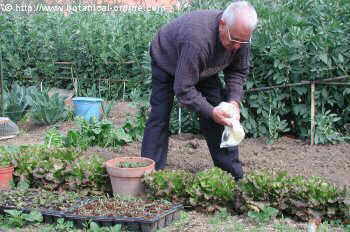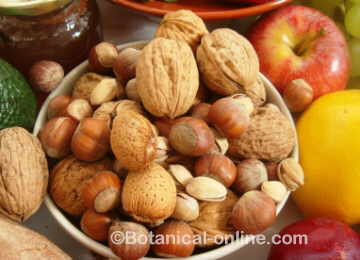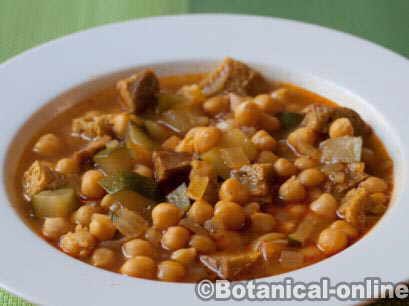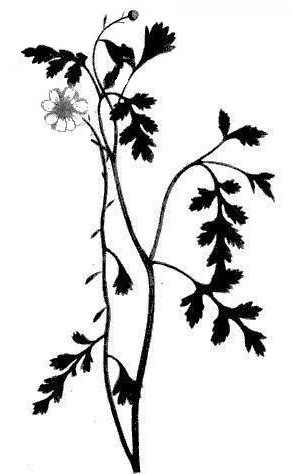Contents
How to grow grapevines
When did grapevine cultivation begin?
Grapevine growing goes back to ancient times. It is present in Greek mythology in Dionysus (Bacchus), god of wine and war.
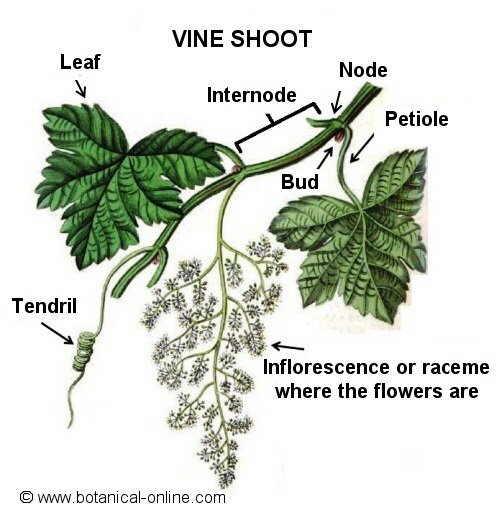
Drawing of a grapevine shoot. Parts of a grapevine
Description of grapevine
– Grapevine or common grapevine (Vitis vinifera) is a plant native to Asia Minor and the Caucasus, naturalized in the Mediterranean region and North Africa.
– The Vitis genus comprises about 65 species of deciduous shrubs or vines, creeping or trailing, from Vitaceae family.
– The trunk or stump of this plant is cylindrical, with long branches (grapevine shoots) sprouting from it
– The branches have nodes with buds where leaves and new fruits sprout each year.
– As a grapevine gets older, branches will become lignified, acquiring a brownish tone with a crust that melts into strips. In some species, they can reach 30m. long.
– It generally has deep roots, but this may vary according to species.
– It has alternate leaves, toothed, palmately, most of them heart-shaped, divided into 3-7 lobes. In autumn, before falling, the leaves turn a yellowish color.
– Tendrils can appear in place of the leaves. They allow the plant to climb, or crawl on the ground if not supported.
– The inflorescence is a raceme or cluster in which flowers are arranged. The clusters can be conical, cylindrical or ovoid. It blooms in spring and contains 5 petals. Flowers are inconspicuous and have a yellowish-green color.
Grapes, grapevine fruits
The fruits are berries (grapes) that are available in the cluster, formed from flowers. Grains can be ellipsoidal, elongated, spherical or ovoid. Inside, they contain the plant seeds, known as pips.
| Did you know… Grapes seems to be a fruit specially designed for the production of wine: They contain a wealth of sugars, abundant juice, and a natural tendency to ferment due to the abundance of yeasts in fruit |
Grapevine uses
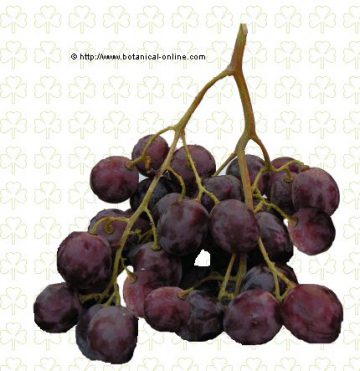
- Getting fruit: the fruit (grapes) is eaten fresh or dried. Grapes are a fruit very present in the Mediterranean diet.
All species of grapevines produce fruit, but in some varieties they are too harsh and should be used in the production of jams, cakes and drinks.
- Raisins: Dried fruits are called raisins. Raisins are a type of dried fruit very rich in energy and sugars which are taken throughout the year. They can be eaten alone, with nuts or added to cakes, cookies and even salads.
- Wine: wine is a fermented drink obtained from grape juice.
- Leaves: Grapevine leaves are edible wild plants whose tender young leaves are consumed. They are used to wrap meat, rice, mushrooms, etc.. This use is applicable only to edible crops, since pesticides use contaminates leaves in grapevine cultivation aimed to produce wine or grapes.
- Water: From its tender branches water can be removed for drinking if necessary.
| Did you know… The discovery of healthy flavonoids in grapes and wine, as the resveratrol, have increased interest in this drink. Resveratrol is considered a good antioxidant, anticancer and heart-healthy. However, wine should be taken in small quantities due to its alcohol content. * More information: Wine Flavonoids |
Grapevine varieties
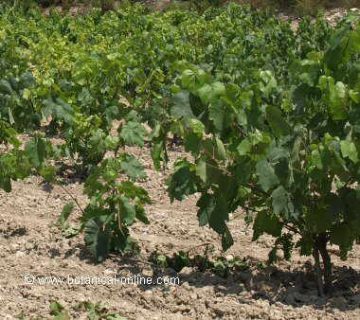
Grapevine is an ancient crop that is used for the production of fruit or wine production. Depending on your target species are most appropriate for each case.
In general, grapevine growers value each variety according to the following parameters:
- Resistance to phylloxera,
- Adaptation to the type of terrain and climate (dry, chalky soil resistance, etc..)
- Ease of multiplication of the plant
- Compatibility with the species to graft (if a variety has affinity with V. vinifera grafts),
- Resistance to nematodes that affect the crop and of course, the quality of the fruit.
| MORE INFORMATION |
Grapevine crop cycle
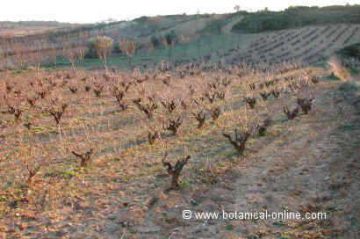
– It is a deciduous plant, the latency period is from late February to early March.
– When the plant begins to bud, grafting is done.
– The leaves of the plant can profit for livestock.. However, it must be done moderately, as this can cause the plant diseases if carried in excess.
– The plant produces fruit in the second year after being grafted.
– The plant is self-fertile. There may be cross-fertilization between plants.
– The grain is formed in autumn: initially greenish, it is rich in acids. As it matures, the grain is rich in sugars, water and takes on a more whitish or black color. At that time, the branch wood also be lignified, becoming brownish color. Then the graft can be performed by eye sleeping.
– In the third year of production is normalized. The strain is fully developed the fifth year.
Suitable climate for grapevines
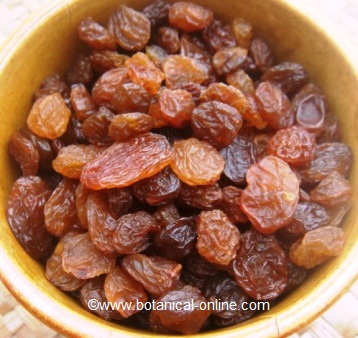
– Grapevines are well adapted to the Mediterranean climate and the Caucasus and Asia Minor.
– There are varieties of grapevines most appropriate for each type of terrain and climate.
– In colder regions to the aforementioned, the outdoor cultivation of the this plant is not recommended, although there are some varieties that can be grown successfully.
– It does not require much watering or rainfall. It is adapted to dry climates with annual precipitations about 700mm.
– Grapevine tolerates the lack of irrigation. However, in very dry years, deficiencies can occur because the roots can not absorb nutrients from the soil due to lack of water.
– It requires mild winters, with temperatures never below -10 or -15 º C. Lower temperatures can cause damage to the plant. The same applies to spring frosts, which can result in loss of harvest. When this happens, clusters never ripen.
– Sensitive to cold and wind. Hailstorms, mists and sprays may adversely affect this crop, promoting cryptogamic diseases or affecting the fruit development.
Grapevines soil
– Grapevines, especially Spanish varieties, can adapt to different soil types.
– They prefer compact and porous soils. Sandy soils do not usually give good results. They tolerate clay soils, but not excessively.
– They can tolerate poor soils with and average depth.
– Ideal soil pH between 6.1 and 7.8.
Farm work
– Avoid excessive watering: it is one of the factors that reduce crop productivity. Also, if the annual rainfall is high, do not allow the plant to become too big, since this will make it more sensitive to fungal diseases and insect attack.
– Protect from frost: we must protect this plant from frost, as it may cause damage and undermine the whole plant fruit production, especially in the spring frosts.
![]()
Grapevine diseases
- Mildew (Plasmopara viticola): fungal disease that appears with moisture and over watering, especially in hot seasons. We can prevent this disease with compost, green manure especially made with nettle, seaweed and horsetail, which improve the natural defenses of the plant. We recommend choosing resistant strains.
- Powdery mildew (Uncinula necator): Powdery mildew is one of the common diseases of grapevine. It appears in spring but its effects may linger during the summer or fall. It is treated with sulfur, however, temperatures above 30 º C can cause burns on plants. Sulfur treatments also remove beneficial insects, so we should l seek alternative treatments (biological control fungi, parasites, potassium bicarbonate, sodium bicarbonate). We recommend choosing resistant strains.
- Botrytis or gray mold (Botrytis cinerea) also known as “gray mold”, it occurs when there is too much moisture in the environment, producing plant rot. Gray or dark spots appear on the plants as mold. There are same factors involved in its appearance as aeration of the grapes, as well as control of powdery mildew and moths.
- Mites (spider mites, yellow spider) especially in warm climate regions.
- Moth Cluster (Lobesia botrana) primarily attacks the flower and fruit.
![]() More information on grapes and wine.
More information on grapes and wine.

